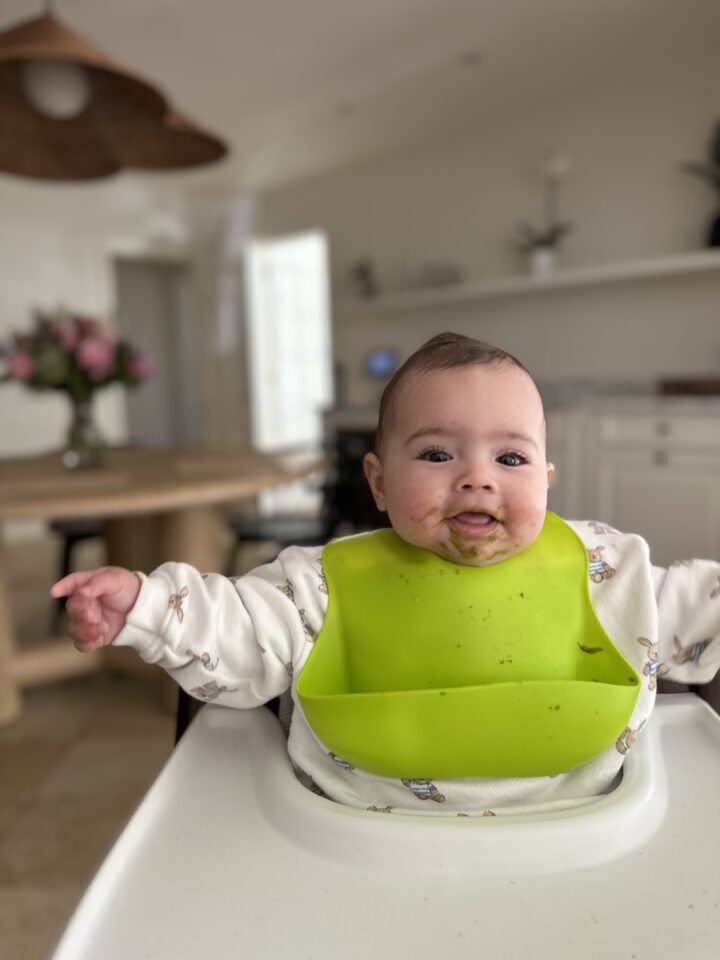Contributed by Kimberly Grenawitzke, OTD, OTR/L, SCFES, IBCLC of Solid Starts
Your baby is eyeing your avocado toast like they’re about to lunge for it. You, on the other hand, are somewhere between excited and mildly terrified. Welcome to the starting solids era – a milestone that’s less “perfectly curated baby plate” and more “food everywhere except the mouth.” We tapped the expert team at Solid Starts, to make sure you’ve got the know-how (and confidence) to help your baby become a happy, healthy eater—without losing your mind in the process. Whether you’re testing the waters or diving right in, we’ve got expert-backed guidance to make mealtimes smoother for everyone.
The transition to solid food is a big milestone in your parenting journey, and it is normal to feel excited, scared, and maybe a little bit of both. At Solid Starts, their goal is to help you raise a happy, healthy eater with guidance that meets you where you are in the journey. Whether you want to take it slow or dive right into sharing real food, you can use their app to find practical solutions backed by research and designed to support you at every stage of introducing solids to your baby. Here are their useful tips and tricks to get you started.
How to tell if baby is ready:
Most babies are ready to start solids around 6 months of age, though some are ready a little earlier, and others a bit later. Rather than looking at the calendar, keep an eye out for the signs that they are developmentally ready for solids:
- Sitting. Baby can sit in a high chair or on your lap with minimal support.
- Head control. Baby can hold head upright and steady while seated (about 15 minutes).
- Reach & grab. Baby can pick up objects while seated and bring them to the mouth.
- Interest. Baby intently watches you eat, mouths for food, or leans forward to reach it.
Once your baby shows all signs, it’s go time! These skills make practicing with real food a bit more enjoyable for your baby, but most importantly, they keep your baby safe at mealtime. As you get started, let your baby explore food at their own pace. Force-feeding leads to more feeding challenges later on.
What you will need: You do not need much gear… most of it is unnecessary. The only things you need are:
- Infant safety training. Know the difference between gagging and choking and how to respond, including infant rescue in the unlikely event of an emergency.
- Safe seating. To minimize the risk of choking, ensure your baby is calm, supervised, and safely seated in your lap or in a high chair with proper support.
- Realistic expectations. Learning to eat takes practice over time. In the beginning, your baby may dig in, watch you, play with or spit out food, or ignore it altogether. All normal.
- Time to eat together. It’s not just baby eating. This is your food, too. Eating the same foods in front of your baby teaches your child how it’s done.
As for bibs, utensils, and other products marketed for baby, good news: most options that you already have in your home will work just fine. Here are the basic necessities:
- a small, lightweight unbreakable open cup and a straw cup
- an unbreakable shallow bowl or plate with a rim
- spoon with short handle
If you like, you can invest in mess management tools like a splat mat, though it is not necessary. An old sheet or trash bag spread on the floor below your baby’s seating area works just fine.
The baby is ready. Now what?
Once your baby is showing signs that they are ready to start solids, and you have your high chair set-up and expectations in check, it’s time to dig in.
- Prepare safe shapes and sizes. Many families assume all food must be pureed or mashed for babies at first. Not so. There are lots of other textures that are safe for babies to explore as soon as they get started. In fact, most foods can be modified to safely share with your baby.
- Drink before solids. A hungry baby is a frustrated baby! Nurse or bottlefeed about 30 to 45 minutes before offering solid food. This way, your baby is happy, rested, and ready to practice eating at the table.
- Eat with your baby. Babies learn by watching what we do around food. When you are ready to begin, let your baby sit on your lap or in their high chair, and watch as you take bites. Move slowly so they can watch how you pick up food, bring it to your mouth, and take a bite. If baby shows interest, offer food and let them try.
- Don’t put food in baby’s mouth. One of the best ways you can minimize the risk of choking is to let your baby practice feeding themselves. Avoid the urge to put the food in baby’s mouth. Instead, you can hold food or a spoon in the air within reach of your baby, and let them lean in and grab it with their mouth or their hands.
- Let baby set the pace. Solid food is an entirely new experience for your baby and it’s not uncommon for it to take some time for it to click. Place some food in front of your baby on the tray or table, and wait. Some babies like to hang out in the high chair for a couple minutes before exploring food. That’s okay!
- Prioritize exploration. It’s not about how much solid food your baby eats, especially at first. In the beginning, your baby is learning about food and getting the hang of it. Touching, smooshing, and exploring food is all a win, even if no food was swallowed.
- Once a day for solids is fine. For the first few months, no need to offer food more than once or twice a day. It’s also fine to skip some days! If your baby is sick or having an off day, or it simply doesn’t work in your schedule, take the day off.
- Keep it simple at first. Unless your baby is high risk for allergies and your doctor has recommended a specific pan, you can give yourself a week or two with solids before jumping into peanut, egg, and other common food allergens. While it’s important to introduce allergens early on, it’s totally okay to give baby and yourself a bit of time to get the hang of solids before diving in.
- Stay positive. Your baby may not touch food. They may struggle picking up food. They may even get frustrated and cry. No matter what happens, try to stay calm. Your baby wants to feel safe and supported while practicing with real food at the table with you. If the meal starts to go awry, offer a little support. If that doesn’t help, end the meal. There is always tomorrow.
Bottom line: let baby take the lead.
You don’t have to overthink this (promise). Babies are wired to learn how to eat – it just takes time, patience, and a willingness to embrace the mess. Let them explore, follow their cues, and trust that they’re figuring it out in their own way (yes, even if most of the food ends up in their hair…or yours). And if you need backup, Solid Starts has your back. Download the app or check out their new book Solid Starts: How to Introduce Solid Food and Raise a Happy Eater (out April 1st, pre-order now). Because mealtime should be fun—for both of you.




